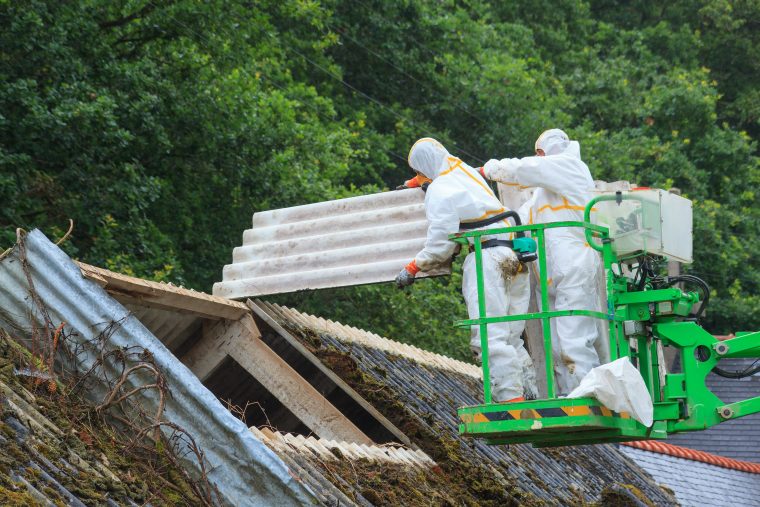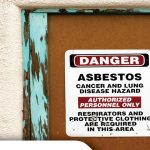Part IV – PRECAUTIONS FOR ASBESTOS
This section provides a list of key things to do and to avoid doing when planning any work on or around asbestos. The precautions are aimed at preventing the release of asbestos fibres and are the same for the workplace and the home.
Remember to check Colombian laws before you commence.
4.1 Working indoors
DO
- isolate the area you are working on from the rest of the building by closing and sealing internal doors
- cover the floor with heavy-duty plastic sheeting to catch dust, debris and offcuts
- keep other people away from the area until the work is completed, and the area is cleaned.
DON’T
- spread asbestos dust through areas of the building that are not protected by plastic sheeting (for example, by walking through unprotected areas).
4.2 Working outdoors
DO
- inform neighbours of the proposed work, and advise them to close doors and windows while the work is being undertaken
- close all windows and doors and cover air vents to prevent asbestos fibres from entering the building
- avoid contaminating the soil by covering the ground and vegetation with heavy-duty plastic sheeting to catch dust, debris and offcuts
- remove play equipment, personal belongings and vehicles from the work area
- keep other people and animals away until the work is completed, and the area is cleaned.
DON’T
- work with asbestos on a windy day.
4.3 Handling or removing asbestos materials
DO
- wear the appropriate personal protective clothing and equipment (see information sheet on personal protective equipment)
- thoroughly wet down the material before you start and regularly during the work by lightly spraying surfaces with water until packaged for transport. This can be done by:
- using a 1:10 polyvinyl acetate (PVA): water solution, or
- with low-pressure water from a garden hose (if outdoors)
- use non-powered hand tools (e.g. a guillotine, hand saw or hand-powered drill)
- pull out any nails, screws or other fixings first to help remove sheeting with minimal breakage
- carefully lower (not drop) the asbestos material to the ground and stack on two layers of polythene sheeting at least 0.2 mm thick (such as heavy-duty builder’s plastic)
DON’T
- use high-pressure water jets to wet surfaces as this may increase the spread of loose fibres or dust
- slide one sheet over the surface of another as this may damage the surface of the materials, and increase the likelihood of releasing fibres and dust
- use power tools, abrasive cutting or sanding discs, or compressed air on asbestos cement
- dry-sand, wire-brush or scrape surfaces to be painted
- walk on corrugated asbestos cement roofs as they can be brittle and break, causing falls
- leave asbestos cement products lying around where they may be broken or crushed.
4.4 Cleaning up
DO
- thoroughly clean the work area, tools and equipment as soon as possible after finishing the job
- clean up any asbestos cement residues in the work area, and on the tools and equipment with wet rags and a wet mop, or with an industrial vacuum cleaner fitted with a Dust Class H (high hazard) high-efficiency particulate air (HEPA) filter. Do not use attachments with brushes because they are difficult to decontaminate
- double bag and seal any materials used during the decontamination, such as rags and mops for disposal with the other asbestos waste
- keep dust, debris and offcuts damp with water
DON’T
- remove any materials from the work area until cleaned up as described above
- clean the work area by dry sweeping or by using a household vacuum cleaner
- store or reuse asbestos cement sheeting
- leave asbestos cement products around your home or backyard
4.5 Packaging and disposing
DO
- Keep the asbestos material wet until it is wrapped and sealed, or bagged
- Wrap the material (including any offcuts or contaminated items) in two layers of 200 µm plastic sheeting or double-bag in asbestos waste bags
- Completely seal the packages with adhesive tape
- Put asbestos warning stickers on the outside of the packages or bags, or clearly label the packages or bags ASBESTOS WASTE using a permanent marker pen
- as soon as possible, securely transport and dispose of the packages at a designated asbestos waste disposal site in your area
- alternatively, hire a mini skip from a waste removal company that specializes in asbestos to fill with your bagged asbestos waste and have it collected by the waste company.
DON’T
- dispose of asbestos waste in a domestic garbage bin or rubbish skip
- reuse or recycle asbestos waste
- dump asbestos waste illegally
- dispose of asbestos during council ‘hard rubbish’ collections.
4.6 Removing personal protective equipment
DO
- carefully peel off coveralls and gloves, turning them inside out as you go
- immediately double bag and seal all these items in two 0.2 micrometer thick (heavy-duty) polythene bags and clearly label the packages ‘ASBESTOS WASTE’ using a permanent marker pen
- dispose of these bags with the other asbestos waste
- wash or wipe reusable footwear using wet rags
- leave the respirator on until the contaminated clothing is removed, bagged and sealed, then dispose of the respirator by doubling bagging
- shower and wash your hair, hands and fingernails immediately afterwards, regardless of whether gloves were used, to remove any dust and asbestos¬.
DON’T
- keep or recycle disposable protective equipment, for example, by shaking the dust out of overalls or cleaning items with a vacuum cleaner
- launder or clean gloves as the asbestos removal and laundering process causes physical damage and deterioration of the gloves.










